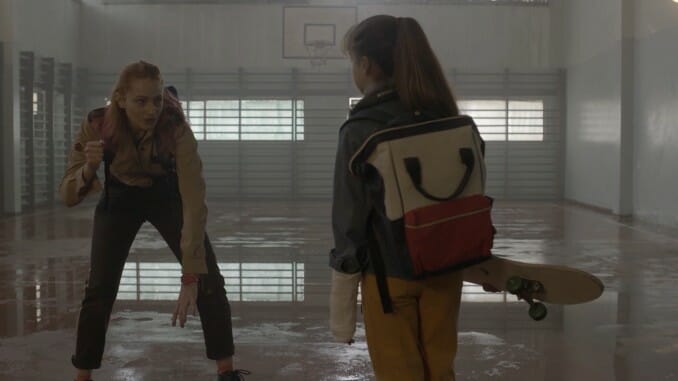Viral Outbreak Thriller Virus: 32 Infects with Creative, Familiar Horror

Gustavo Hernández of The Silent House fame presents his rendition of 28 Days Later with Virus: 32. The Shudder Original relies on tighter budgets and less expansive worldbuilding than its influences, but doesn’t hesitate to indulge in viral rage. Hernández and co-writer Juma Fodde pull from famous infectious disease thrillers—I’d argue they’re zombie flicks, but that’s a soapbox for another day—to concoct their newest strain of “crazed killer” outbreak. Virus: 32 references the signature trademark of infected predators needing a 32-second break to recharge after attacks, which adds something different to the otherwise familiar fast-zombie riffage. That tweak, plus satisfying intensity, goes a long way.
The streets of Montevideo become a scene of ravenous chaos due to the spread of an unknown disease that transforms people into bloodthirsty hunters—but Iris (Paula Silva) isn’t aware. She’s day-buzzed on rum and late for work at a sports club where she’s a security guard. Today, she’s got company after forgetting it’s her turn to watch her daughter Tata (Pilar Garcia). Iris asks Tata to play alone while she patrols and watches over surveillance cameras, assuming another quiet day until invaders break down the facility’s doors. Iris, unaware of the pandemic apocalypse outside, must locate her shaken daughter before the worst happens as crazed lunatics sprint through the corridors.
There’s something survival horror game-esque about Virus: 32; about how Iris must traverse an abandoned complex now filled with rampaging threats hiding around dim, dank hallway bends. Iris conveys instructions over telephones and walkie-talkies while playing eye-in-the-sky, scampering to help her kin—with the bonus of deranged survivors straight out of mall-zombie game Dead Rising. There are maniac humans amidst undead hordes in Capcom’s open-world environment who tend to be just as dangerous—or at least doomsday-unhinged, which Virus: 32 gives us a smaller glimpse into given the film’s contained scope. Iris is our non-playable protagonist caught on side-quests while her main mission timer ticks away, and it’s an exciting connection that not all films indulge. It’s not a videogame movie by adaptation standards, but Hernández still benefits from structural relations.
-

-

-

-

-

-

-

-

-

-

-

-

-

-

-

-

-

-

-

-

-

-

-

-

-

-

-

-

-

-

-

-

-

-

-

-

-

-

-

-








































